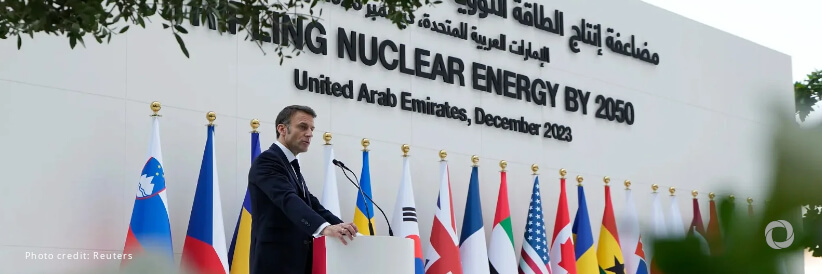Nuclear energy made history as the United Nations Climate Change Conference (COP28) wrapped up in the United Arab Emirates city of Dubai. For the first time since the annual climate summits commenced in 1995, the 198 signatory countries to the UN Framework Convention on Climate Change (UNFCCC) officially called for accelerating the deployment of low-emission technologies including nuclear energy to help achieve deep and rapid decarbonization, particularly in hard-to-abate sectors such as industry and through the low carbon production of hydrogen.
The appeal came in the 28th paragraph of the so-called Global Stocktake, a final agreement that assesses where the world stands on achieving the objectives of the 2015 Paris Agreement and how shortcomings might be rectified. Global headlines about the document, the subject of heated debate in the closing hours of COP28, focused on its call to transition away from fossil fuels and triple renewable energy capacity.
But the inclusion of nuclear, together with a separate declaration made last week at COP28 by more than 22 countries to advance the aspirational goal of tripling nuclear power capacity by 2050, as well as statements by the IAEA and the nuclear industry, underscored the momentum building behind the world’s second-largest source of clean electricity.
See also: Unveiling COP28: A critical meeting to address climate change
“Nuclear energy‘s inclusion in the Global Stocktake is nothing short of a historic milestone and a reflection of how much perspectives have changed,” said IAEA Director General Rafael Mariano Grossi. “It demonstrates there is now a global consensus on the need to scale up this clean and reliable technology to achieve our vital goals on climate change and sustainable development.”
The IAEA Statement on Nuclear Power, released on 1 December at COP28 and supported by dozens of countries, called for active recognition and support for energy technology.
“Resilient and robust nuclear power has the potential to play a wider role in the quest towards net zero carbon emissions, while ensuring the highest level of nuclear safety and security,” the statement said.
The IAEA’s annual nuclear power outlook high case projection sees installed nuclear capacity more than doubling to 890 gigawatts by 2050, compared to 369 gigawatts today. This represents an almost 25% increase from the Agency’s estimate in 2020, with its projections revised up for a third consecutive year.
However, several challenges need to be addressed if nuclear power is to fulfill its potential to help the world get to net zero greenhouse gas emissions by mid-century. These include rising interest rates and commodity prices, the need for a level financial and policy playing field as well as greater regulatory harmonization and industrial standardization, a topic on which the IAEA’s Nuclear Harmonization and Standardization Initiative (NHSI) is advancing global efforts.
The declaration made by more than 20 countries at COP28 on tripling nuclear capacity invited the World Bank, regional development banks, and international financial institutions to include nuclear in their lending policies while underscoring the need for secure supply chains to ramp up deployment of the technology.
In recent years, nuclear power has been included in several national or regional taxonomies on what qualifies as a sustainable investment. However, such moves so far have not influenced the lending principles and policies of banks, including multilateral banks, although some private investment funds appear to be changing their approach.
“Achieving a fair and enabling investment environment for new nuclear projects remains an uphill battle,” Mr Grossi said. “We are not at a level playing field, yet, when it comes to financing nuclear projects.”
At COP28, Belgian Prime Minister Alexander De Croo, French President Emmanuel Macron, and Mr Grossi announced that the world’s first Nuclear Energy Summit will be held in Brussels in March 2024 to build on the global momentum behind nuclear power. Around 30 countries are expected to participate in the Summit along with industry leaders, experts, and representatives from civil society.
In addition, the Summit will showcase the IAEA’s Atom4NetZero initiative, which provides decision-makers with comprehensive, data-driven energy scenario modeling that also includes the full potential of nuclear power in contributing to net zero emissions. Such studies will be vital to make a credible technical case for governments and investors to support new nuclear projects, Mr Grossi said.
“Today we celebrate the real progress that nuclear power has made in the global climate and energy debate,” the IAEA Director General said. “But we must tackle several challenges if we are to succeed. The Nuclear Energy Summit is the next major event where the world will come together to discuss how we can forge real solutions, so that the lofty pledges made at COP28 can become reality.”

